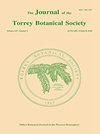两种禾本科植物群体开花物候的遗传变异和表型可塑性
IF 0.8
4区 生物学
Q4 PLANT SCIENCES
引用次数: 40
摘要
QUINN, J. A.(罗格斯大学生态、进化和自然资源系,New Brunswick, NJ 08901-1582)和J. D. WETHERINGTON(杜邦制药公司生物识别部,Wilmington, DE 19880-0721)。两种禾本科植物群体开花物候的遗传变异和表型可塑性。托里·博特。Soc。129:96 - 106。2002.-开花物候的遗传分化已在广泛分布的物种居群中得到证实。然而,开花物候的微调,即对当地环境年波动的反应,最好通过表型可塑性来完成。为了验证遗传分化与可塑性相互作用的理论预期,以及两者相互作用最重要的条件,本研究比较了近交的隐孢子虫(Sporobolus cryptandrus)和近交的维加姆(Panicum virgatum)群体的无性系间遗传变异以及物候可塑性的数量和模式。对于每个物种,在科罗拉多州柯林斯堡附近的一个普通花园中复制的克隆基因型块的三年数据被视为在三种环境中测量的特征,作为量化“环境敏感性”和划分开花时间差异的一种方式。这三年在生长季节长度、温度、降水和蒸发速率方面存在主要差异。远交种群体内无性系间遗传变异最大,近交种群体内遗传变异较小,群体间遗传变异较大。种群数量差异显著,可塑性格局差异极显著。长生无性系Panicum的可塑性明显高于短生无性系Sporobolus。总体而言,孢子草的可塑性变异分量最大,存在于最广泛的时空异质性环境中,种群的生态历史与可塑性在开花物候中的相对重要性之间存在高度显著的关系。这两个物种没有显示出克隆遗传变异数量与可塑性之间的一致关系,强调需要对物种多样性进行实验来适当地测试理论期望。本文章由计算机程序翻译,如有差异,请以英文原文为准。
Genetic variability and phenotypic plasticity in flowering phenology in populations of two grasses
QUINN, J. A. (Department of Ecology, Evolution, and Natural Resources, Rutgers University, New Brunswick, NJ 08901-1582) AND J. D. WETHERINGTON (Biometrics Division, DuPont Pharmaceuticals, Wilmington, DE 19880-0721). Genetic variability and phenotypic plasticity in flowering phenology in populations of two grasses. J. Torrey Bot. Soc. 129:96-106. 2002.-Genetic differentiation in flowering phenology has been frequently demonstrated among populations of wide-ranging species. However, fine-tuning of flowering phenology, i.e., responses to yearly fluctuations in the local environment, should best be accomplished via phenotypic plasticity. To test theoretical expectations as to the interaction of genetic differentiation and plasticity, and conditions under which each should be most important, populations of the inbreeding Sporobolus cryptandrus and the outbreeding Panicum virgatum were compared in genetic variation among clones and in amounts and patterns of plasticity in phenology. For each species, three years of data from replicated blocks of cloned genotypes in a common garden near Fort Collins, Colorado, were treated as characters measured in three environments as a way of quantifying "environmental sensitivity" and partitioning the variance in flowering time. The three years provided major differences in length of growing season, temperatures, precipitation, and evaporation rates. The outbreeding species possessed the greatest genetic variation among clones in a population, while the inbreeding species showed less genetic variation within and more between populations. Populations of both species varied significantly in amount and highly significantly in pattern of plasticity. The long-lived, clonal Panicum showed a significantly greater plasticity than the short-lived, non-clonal Sporobolus. The plasticity variance component was the largest component overall for Sporobolus, which is found over the widest range of environments heterogeneous in space and time, and there was a highly significant relation between a population's ecological history and the relative importance of plasticity in flowering phenology. The two species did not show a consistent relationship between amounts of clonal genetic variation and plasticity, emphasizing that experiments on a diversity of species are required to appropriately test theoretical expectations.
求助全文
通过发布文献求助,成功后即可免费获取论文全文。
去求助
来源期刊
CiteScore
0.70
自引率
0.00%
发文量
16
审稿时长
>12 weeks
期刊介绍:
The Journal of the Torrey Botanical Society (until 1997 the Bulletin of the Torrey Botanical Club), the oldest botanical journal in the Americas, has as its primary goal the dissemination of scientific knowledge about plants (including thallopyhtes and fungi). It publishes basic research in all areas of plant biology, except horticulture, with an emphasis on research done in, and about plants of, the Western Hemisphere.

 求助内容:
求助内容: 应助结果提醒方式:
应助结果提醒方式:


